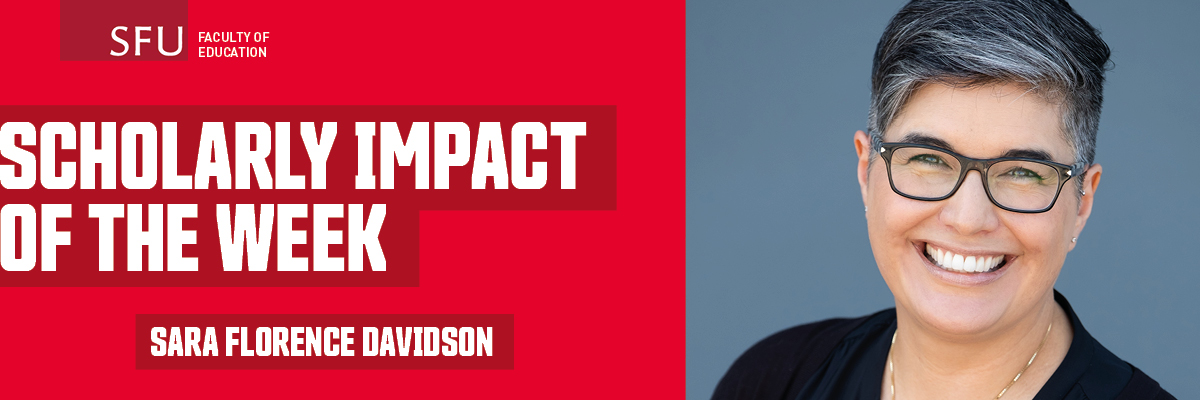
Educational institutions traditionally shaped by colonial ideologies are working to incorporate and appreciate Indigenous knowledges and non-Eurocentric worldviews into their curricula. Educators and researchers are recognizing superdiversity as the norm—whether it be cultural, linguistic, neurological, socio-economic, gender, etc.
Simon Fraser University (SFU) Professor of Education Sara Florence Davidson (sgaan jaadgu san glans) is a Haida/settler scholar, writer and educator whose teaching and research focus on Indigenous pedagogies, literacies and stories. She has extensive experience working with students and teachers in diverse communities at all levels of education. In the classroom and in her scholarship, Davidson embraces all forms of diversity to create deep learning opportunities.
She recently co-wrote a book chapter, Diversity as the Norm: Teaching to and through superdiversity in postsecondary education Indigenous courses, (SFU computing ID required) published in Superdiversity in Teacher Education, with lead author and Professor in Teacher Education at the University of the Fraser Valley Nikki L. Yee. Davidson and Yee share perspectives on teaching mandatory post-secondary Indigenous education courses, in educational environments that are themselves superdiverse.
They explain there is no one pedagogical recipe that is going to support everyone, however, by offering insights from their own experiences as superdiverse educators, Davidson and Yee challenge readers to examine their own ideas of what it means to teach Indigenous education.
We talked with Professor Davidson about her teaching and research.
In your book chapter, you and Yee describe how taking an Indigenous content course can help teacher candidates (TCs) build a foundation for working across all cultural communities in their roles as teachers. Can you elaborate?
I believe that working together to learn more about Indigenous education can serve as a model for how we might engage with and learn across diverse communities. Specifically, to engage with Indigenous education, we need to prioritize building respectful relationships, honour diverse perspectives and make space for Indigenous contributions in our educational spaces and practices. I believe this approach can guide us to consider what might need to be prioritized when learning across diverse communities. Committing to respectfully learning from these communities will make classrooms more ethical spaces of engagement for all students.
An important part of your teaching ethos is to create not just safe spaces where people feel comfortable to contribute and share, but also ethical spaces. Can you explain what you mean by ethical space?
According to Cree scholar Willie Ermine, an ethical space is “a venue to step out of our allegiances, to detach from the cages of our mental worlds and assume a position where human-to-human dialogue can occur.” In the chapter, Yee and I describe the different ways in which we take up this idea. For example, I begin my courses, by providing direct instruction and facilitate discussions about how we will engage in conversation, ask questions and address people’s discomfort. In this work, the priority must be to ensure that students are not retraumatized by participating in course activities while still supporting full and meaningful engagement with their peers and the course content.
Within your teaching practice, you have identified four distinct approaches to encourage deep engagement with Indigenous and decolonizing perspectives. Can you describe these for us?
In the courses I have taught, the emphasis on sharing diverse perspectives (including non-Indigenous voices) was vital. In my experience, we have a false belief that all Indigenous peoples have similar views and so it was important to me to reflect differing, and at times conflicting perspectives to emphasize the diversity among Indigenous peoples.
It was also important to share the ways in which non-Indigenous folks are taking up this work in meaningful ways. This provides a model for non-Indigenous educators to take up the work rather than distancing themselves from it—or adopt—as Susan Dion describes, the stance of ‘the perfect stranger’ and thus avoid engaging in this work.
I found that bringing art and literature into the courses invited more of a heart connection for the students which supported more transformational learning. Co-constructing knowledge is definitely a central tenet of Yee’s work, though I take it up by inviting students to contribute with what they already know about a topic or supporting students’ own inquiry-based learning which is shared with the larger class.
Learning from place is also an incredibly important experience for students and hopefully it opens the possibilities to learn from different kinds of experiences rather than assuming that learning can only take place through direct instruction.
You mention that using the First Peoples’ Principles of Learning is a particularity impactful exercise. What does it mean to plan, teach and learn while being guided by First Peoples’ Principles?
The First Peoples Principles of Learning, as defined by The First Nations Education Steering Committee, are a set of Indigenous pedagogical principles that were developed to guide curriculum development for English First Peoples and were later used to guide the redesign of the British Columbia Curriculum to include Indigenous knowledges and pedagogies across all grades and content areas. Their depth is often overlooked, so in my class I supported teacher candidates to work with a small group to build an inquiry around one of the principles. They would begin by engaging with the readings through the lens of the principle, then consider the implications for pedagogy, and finally plan and teach small lessons that centred the principle from their inquiry.
To learn more about Sara Florence Davidson’s work as an educator and author, visit her web page at: www.saraflorence.ca.
SFU's Scholarly Impact of the Week series does not reflect the opinions or viewpoints of the university, but those of the scholars. The timing of articles in the series is chosen weeks or months in advance, based on a published set of criteria. Any correspondence with university or world events at the time of publication is purely coincidental.
For more information, please see SFU's Code of Faculty Ethics and Responsibilities and the statement on academic freedom.